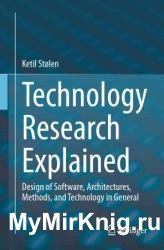 Название: Technology Research Explained: Design of Software, Architectures, Methods, and Technology in General Название: Technology Research Explained: Design of Software, Architectures, Methods, and Technology in General
Автор: Ketil Stølen
Издательство: Springer
Год: 2023
Страниц: 185
Язык: английский
Формат: pdf (true)
Размер: 10.2 MB
Technology science is the science of creating, inventing, or designing new things in the form of human-made objects, so-called artifacts, commonly referred to as technology. In this book, we refer to natural science, social science, and other kinds of science concerned with understanding the world as it is, including the artifacts that already exist, as explanation science.
Technology science often involves explanation science, for example, to better understand the properties of materials needed to build new artifacts. Then the use of explanation science is subordinate to the end goal of inventing an artifact to fulfill some (potential) human needs. Accordingly, explanation science involves technology science to create new specialized instruments, probes, etc. to uncover factual relationships and better understand reality.
Sciences such as physics, chemistry, and biology belong at least historically mainly to explanation science, although they have also made outstanding contributions to technology science. Most social sciences also belong mainly to explanation science. Explanation science is science aiming at understanding reality as it is. Explanation science focuses on capturing, understanding, and characterizing reality. Explanation science studies reality as it is, in contrast to the technology science that extends reality with new artifacts.
This book aims to help research practitioners in technology science avoid some of the most common pitfalls or at least make them easier to overcome. Many technology scientists put too little weight on how they conduct their work and should be able to become significantly better at what they do by being more aware of methodological issues. The book differs from other related works in two main respects: First, by focusing on creating, producing, or inventing new artifacts – in other words, technology science. Second, by describing a general approach to technology science linking together specialized research methods.
Machine Learning (or ML for short) is widely used for all kinds of scientific work. Some argue that ML is also changing the way we do research and the scientific method as such. It therefore makes sense to discuss the relationship between ML and what has been presented in this chapter. ML augments systems with capabilities that seemingly mirror those of human intelligence. These capabilities may improve the effectiveness and automate tasks that previously required human intervention. ML is mainly good at low-level pattern recognition when analyzing data sets too large to make human processing practical. To build ML, we need data. The data is split into training data and test data. Roughly speaking, the training data is used to teach the software to become “intelligent,” and the test data is used to check whether the software became “intelligent.” The training may take place offline, online, or both offline and online. Hence, the data is not always collected in advance. The final result of the training process is known as the ML model. The ML model is a software program that analyzes input and produces output in an “intelligent” manner. The ML model is an artifact like any other software program. However, its engineering is different because it represents the output of another software program that has performed the learning process. Human engineering of ML means engineering the learning process. The learning process is also an artifact.
The book consists of 14 chapters. Following the first introductory chapter are two chapters providing the foundation for the rest of the book. These chapters clarify the meaning of key concepts and describe an overall process for technology science. The subsequent chapters 4–11 are about this process. Chapters 4, 5, and 6 concern problem analysis, research planning, and hypothesis formulation. The following five chapters then aim at evaluation. Chapter 7 introduces the concept of prediction, which plays a fundamental role in evaluating hypotheses. Chapters 8–10 address the evaluation of universal, existential, and statistical hypotheses. Chapter 11 concerns quality assurance and introduces the concepts of validity and reliability. Next, in chapters 12 and 13, we address publishing with an emphasis on the specifics of technology science. Eventually the last chapter, chapter 14, briefly introduces the philosophy of science.
Скачать Technology Research Explained: Design of Software, Architectures, Methods, and Technology in General
|